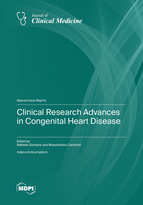Clinical Research Advances in Congenital Heart Disease
A special issue of Journal of Clinical Medicine (ISSN 2077-0383). This special issue belongs to the section "Cardiology".
Deadline for manuscript submissions: closed (20 June 2023) | Viewed by 18436
Special Issue Editors
Interests: cardiovascular sciences; adult and pediatric cardiac surgery; congenital heart disease
Special Issue Information
Dear Colleagues,
Though the number of infants born with heart disease each year is relatively small (approximately 1% of the population), it is still a substantial issue worthy of investigation, which is why this Special Issue focuses on congenital heart disease in both children and adults. Advances in the treatment of such malformations have led to increased life spans for this population. Consequently, today, most patients treated for congenital heart disease are adults. The purpose of this Special Issue is to deal with the latest developments in the care of the fetus, infants, children, and how these patients should be treated, as well as describe the results of follow-ups and the potential special needs of adults with congenital heart disease.
We welcome original manuscripts or other types of papers concerning all aspects of heart disease in infants, children, and adolescents, including embryology and anatomy, physiology and pharmacology, biochemistry, pathology, genetics, radiology, clinical aspects, investigative cardiology, electrophysiology and echocardiography, and cardiac surgery.
Dr. Raffaele Giordano
Dr. Massimiliano Cantinotti
Guest Editors
Manuscript Submission Information
Manuscripts should be submitted online at www.mdpi.com by registering and logging in to this website. Once you are registered, click here to go to the submission form. Manuscripts can be submitted until the deadline. All submissions that pass pre-check are peer-reviewed. Accepted papers will be published continuously in the journal (as soon as accepted) and will be listed together on the special issue website. Research articles, review articles as well as short communications are invited. For planned papers, a title and short abstract (about 100 words) can be sent to the Editorial Office for announcement on this website.
Submitted manuscripts should not have been published previously, nor be under consideration for publication elsewhere (except conference proceedings papers). All manuscripts are thoroughly refereed through a single-blind peer-review process. A guide for authors and other relevant information for submission of manuscripts is available on the Instructions for Authors page. Journal of Clinical Medicine is an international peer-reviewed open access semimonthly journal published by MDPI.
Please visit the Instructions for Authors page before submitting a manuscript. The Article Processing Charge (APC) for publication in this open access journal is 2600 CHF (Swiss Francs). Submitted papers should be well formatted and use good English. Authors may use MDPI's English editing service prior to publication or during author revisions.
Keywords
- congenital heart diseases
- pediatric cardiology
- pediatric cardiac surgery








